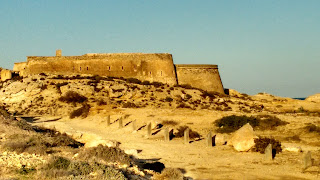Around the coast of the Cabo de Gata there are several fine castles or forts built in the 16th - 18th centuries to protect the coast from pirates who would hide in the isolated coves and then carry out raids, both on passing ships and on villages. There is an 18th century one here on the beach el Playazo de Rodalquilar, called Bateria de San Ramon, which is in private hands now; it's restored and lived in (at least part of the time):
A magical place to live!
On the way to El Playazo from Rodalquilar village, next to the path there is an older castle than San Ramon, Torre de los Alumbres, built in about 1510 in order to protect the alum mining. The castle is a ruin now but it is still impressive.
There is another fort very like San Ramon, the Bateria de San Felipe, just a little way down the coast at the tiny hamlet of Los Escullos, this one, owned by the state, has also been restored. Unfortunately, although you can stare in through the grating at the main entrance, you can't get into the fort.
View through the grating:
The 16th century castle, Castillo de San Andres, at the small town of Carboneras, further up the coast from Rodalquilar, is both restored and open to the public!
There was originally an 18th century castle on the headland at San Jose, and when Goytisolo visited the area this castle was still there although it was almost in ruins. In the 1980s it was pulled down and a large barracks and central office for the civil guard was erected in its place!
Here are photos of the barracks:
From a distance, it looks a little like a castle but close-up it's just an ugly concrete ghetto, set apart from the rest of San Jose.
As I've mentioned in a previous post, the offices and exhibition centre of the botanic gardens in Rodalquilar are housed in a building originally for the civil guard stationed here to protect the gold mine. After the mine was closed in 1966, the civil guard remained here until the early 1970s when they were moved to the village of Las Negras. Then, in 1983, the civil guard for the whole of the Cabo was centralised in San Jose.
The forts were built to house battalions of soldiers ready to defend the coast from Arab invaders, following the expulsion of the Moors after the conquest by Ferdinand and Isabella at the end of the 15th century, and later, in the 17th and 18th centuries, to protect against pirates. It wasn't only Arab invaders and pirates who were the danger, but also English. Catholic Spain and Protestant England were at loggerheads for a long time from the 16th century onwards.
Imagine the excitement and terror of the chase! When the prey ship trapped in open sea, no safe harbour before Carthagenia - a long way up the coast - saw the pirates fast approaching in full sail, ruthlessly captained by men like the infamous British pirate, 'Captain Slime'.
There are also 18th century watchtowers built on the cliffs along the coast to give the alarm in the event of attack by pirates. Our nearest one is Torre de los Lobos, on a hill above the Valle de Rodalquilar:
There is a staggering view from the summit, it must have been an excellent look-out point!
At the moment I'm re-reading one of my favourite novels, The Nautical Chart, by Arturo
Perez-Reverte - or to be accurate, I'm listening to it again, as I have
to rely largely on audiobooks. I can't hold anything for longer than a
few minutes and I can't look down at anything, so if I'm going to read
print I have to use a special lectern or a 'book chair' - and that has
to be at eye level - to hold the book or newspaper, etc. So I'm actually
listening to The Nautical Chart again.
It's really
interesting listening to it while I'm here on the Cabo de Gata because
much of it is set along this coast. It makes a lot more sense to me
than it did when I listened to it in London and I'm learning quite a lot
of things I didn't know. For example, I didn't know the cove of the
small fishing village, La Isleta del Moro, used to be called Cala
('Cove') Arraez after a notorious North African pirate, Mohamed Arraez.
Even now he is still remembered in its name, 'The Isle of the Moor'.
In the 18th century, when the village was only inhabited by a few poor
fishermen, the cove was used by pirates, both North African and British.
They would anchor their sailing ships in the cove and hide there until
they saw a ship go by out in open sea that looked as if it might be
carrying anything valuable. Then they would give chase, taking it by
surprise, in order to attack, steal the cargo, and enslave or kill the
crew.
It's not surprising that the Bateria de San Felipe was built at Los Escullos, very close to La Isleta del Moro!
Here are some photos of the cove today:
In this photo you can see the small island for which the village is named:
Here is a photo of an old map, like the nautical chart the characters are using in the novel:












No comments:
Post a Comment